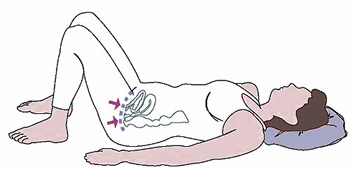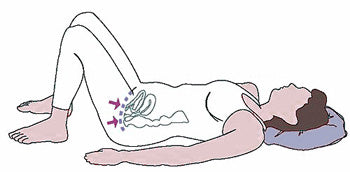Author: Kegel8
If you're wondering how to Kegel correctly, you have come to the right place. Pelvic floor exercises should be an important part of both men and women's daily exercise routine. Pelvic exercises strengthen the core muscles that support your pelvic organs such as your bladder, bowel and uterus, and a strong and healthy pelvic floor means no leaks, less chance of prolapse and greater intimate sensation for both you and your partner.

Pelvic floor exercises aren't a new thing – they were developed in 1948 by Dr Arnold Kegel (hence 'Kegel exercises') who realised the importance of strong pelvic muscles to help with prolapse, help with natural childbirth and prevent incontinence. Yet, 1 in 2 women don't know how to produce an effective pelvic floor muscle contraction.
What are Kegel Exercises?
Kegel exercises are the repetitive contraction and relaxation of the pelvic floor muscles, also known as the Kegel muscles. Regular pelvic floor exercises help to improve and maintain the strength of your pelvic floor, in the same way as you workout other parts of your body.
Kegel exercises may not be something you expect to include in your exercise routine, but they should be a focus for everyone. This act of squeezing and relaxing your pelvic floor is vital to keep your pelvic floor muscles strong and supportive. They are even more essential if you workout often, as high impact exercises such as running and lifting weights put an immense pressure on your pelvic floor - leading to the muscles weakening or overstretching if they are not cared for. But, do Kegels actually work? How do you know if you’re performing them correctly? For how long should you hold your pelvic floor muscle squeeze?
To reap the benefits of Kegel exercises, you must first learn the correct technique.
How To Do Pelvic Floor Exercises For Women (A Step-by-Step Guide)

- Slow Kegel Exercises - Sit, stand or lie with your knees slightly apart. Slowly tighten your pelvic floor muscles starting with your anus (as if you are trying not to pass wind – the biggest part of your pelvic floor muscle is located here), then tighten around your vagina, squeeze both areas and lift (or 'suck-up' your muscles) as hard as you can. Hold for the count of five, then relax, repeat 5 times.
- Fast Kegel Exercises - As before (Anus/Vagina/Squeeze/Lift) but quickly for two seconds, then relax for two seconds. Repeat five times
- Try to vary your Kegel exercising by alternating between 5 slow kegel pull-ups and 5 fast Kegels. Ideally for five minutes.
- Ideally you should do your Kegels for about five minutes at least three times a day – if you have time try to do more. Preferably 6-10 times a day. It may take between 8-20 weeks to see improvement in your pelvic floor muscle strength.
Pelvic Exercise Positions
1. Lying Down
When you start doing kegels, particularly if it's to recover from surgery, you'll probably find it easiest to do them lying down. Lying down offers the least amount of resistance for your pelvic floor muscles, making it much easier to contract them.
Lie on your back with your legs stretched out. Relax and do a Kegel - if you're using a Kegel8, insert your probe before lying down or use the electrode pads on your lower back. If lying on your back is uncomfortable you can try lying on your side with your legs bent at an angle instead. As you get stronger you can try more strenuous positions like sitting up. This will increase the amount of resistance and help you to gradually do more intense and effective Kegels.
2. Standing Up
Most pressure is on your pelvic floor when standing, causing symptoms to worsen. If you suffer from stress incontinence, Kegel exercises are useful throughout the day to prevent leaks when sneezing, coughing or laughing. Pelvic floor physiotherapist, Amanda Savage, advises that by positioning the feet differently when in a standing position, you can target and exercise/strengthen different areas of the pelvic floor. View our Kegel exercise techniques video with Amanda Savage for more information.
Ensure you don't tense the glutes and abdominals. Working other muscles alongside your pelvic floor prevents full Kegel benefits. Contracting your abs too much puts a lot of pressure on your pelvic floor, causing painful spasms and potentially making conditions like prolapse worse.
3. Sitting Down
This position enables you to target the right muscles with the right amount of resistance, as it's midway between standing and sitting. But do sit well! The Australian Journal of Physiotherapy confirmed this in a 2006 study [1]. It looked at three different positions for pelvic floor exercise - slumped and supported by a backrest, upright but unsupported and very tall and unsupported. As the women in the study sat more upright, the level of activity in their pelvic floor muscles increased. Sitting up straight in a 'very tall' position was found to be the most effective position for Kegels.
How Long Do Kegel Exercises Take to Work?
It is recommended to do classic independent Pelvic Floor Exercises, as described here, 3 x a day for 12 weeks. In this time, you should see improvement in both your skills and your symptoms. If you don’t, it is time to seek further assessment & advice. If you are making some progress, but it seems slow or you find it difficult to remember to exercise, you could introduce an exercise device to help you and motivate you.
Some women have such weak pelvic floor muscles, they are unable to even gently contract them effectively in order to strengthen them. This is common for women who have been pregnant and post-menopausal women. If the pelvic floor is very weak it is recommended to do assisted pelvic floor exercises using a stimulation device.
With independent Kegel exercises, it's hard to pinpoint when you will see improvement. Everyone will see results at different times and if you don’t suffer with leaks or other signs of pelvic floor weakness, progress can be difficult to identify. And this is where ‘giving up’ comes in; but with Kegel8 it is easy to keep motivated with one of our biofeedback devices.
Make it Easy with a Kegel Exerciser
The same as an ab belt will do for your stomach, an electronic pelvic exerciser will do the work for you! The Kegel8 Ultra 20 is the UK's No. 1 pelvic toner, with clinically proven programmes to ensure your pelvic floor is strong and healthy. Using neuromuscular electrical stimulation (NMES), Kegel8 ensures your kegel exercises are efficient by stimulating your pelvic floor muscles to contract in the right way; and of course, relax. In fact, there’s even a programme designed specifically for relaxation, so if you do suffer with pelvic pain or muscle tightness, Kegel8 can train your muscles to relax and recover.






